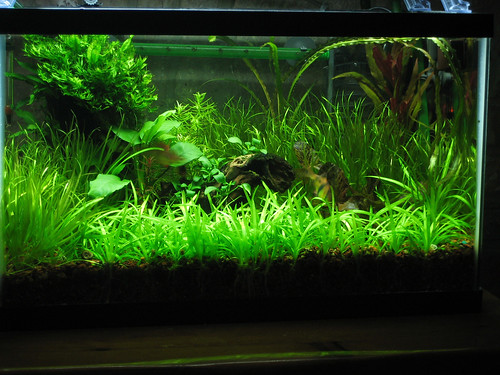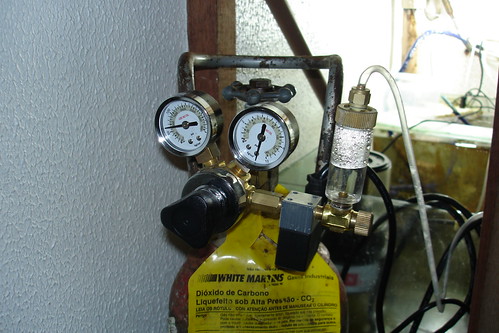The Basics Of CO2 Injection For The Planted Aquarium
 Providing some form of carbon to plants in a high light system is a necessity. Plants utilize carbon during photosynthesis to produce glucose, which is what the plants use for energy. In a high light situation the plants are growing quickly and require a lot of energy to maintain health and the quick growth, therefor they need a lot of carbon. One of the easiest ways to add supplemental carbon to your planted aquarium is via the use of carbon dioxide (CO2). If you have a low light tank additional CO2 is not usually neccessary. If you feel your plants in a low light tank are needing a carbon source try flourish excel.
Providing some form of carbon to plants in a high light system is a necessity. Plants utilize carbon during photosynthesis to produce glucose, which is what the plants use for energy. In a high light situation the plants are growing quickly and require a lot of energy to maintain health and the quick growth, therefor they need a lot of carbon. One of the easiest ways to add supplemental carbon to your planted aquarium is via the use of carbon dioxide (CO2). If you have a low light tank additional CO2 is not usually neccessary. If you feel your plants in a low light tank are needing a carbon source try flourish excel.
DYI Yeast CO2
There are a couple ways to do add CO2 to your planted aquarium. One is to mix yeast, sugar and water in a container and run tubing from the container to the tank to some kind of "reactor". A reactor can be anything that delays the CO2 from reaching the surface of the tank, so that it can dissolve into your aquarium water. There are many different ways to make a "reactor", I will touch more on that below. If you do not want to make your own system you can purchase a ready made one like Hagen's Nutrafin Co2 Natural Plant System from your local fish store. Using the yeast method to get CO2 can work in smaller tanks, but the CO2 production is unstable and unreliable. For larger tanks it can become very time consuming making up enough bottles to keep up with your CO2 needs. Many people start out with yeast CO2 but soon tire of constantly having to remake the bottles of yeast, sugar and water.
Pressurized CO2
This is where pressurized CO2 injection comes into play. With pressurized CO2 you have a cylinder ( aka tank) of liquid CO2, a regulator, a needle valve, a bubble counter (optional), and a CO2 diffusion reactor.
( aka tank) of liquid CO2, a regulator, a needle valve, a bubble counter (optional), and a CO2 diffusion reactor.
The Cylinder
CO2 cylinders are designed to hold liquid CO2. The pressure of a CO2 cylinder, filled is about 1,000 psi. It is important to use a cylinder that is specifically made to hold CO2 as others may not be able to handle the high pressure needed to keep the CO2 in liquid form. CO2 cylinders can be found in sizes from 2.5 pounds to 20 pounds. The most common size is 5 pounds. These can be found at wielding supply stores and beverage distributors. The cylinder may come in aluminum or steel. Both will work fine, the aluminum is lighter and does not rust, but cost more than the steel normally. Ideally you will want to buy a cylinder that is already filled, that you can take back to exchange for another one that is filled once yours is empty. If you purchase an empty cylinder you will need to find a place to fill it and you will also need to get it inspected regularly. The CO2 cylinder needs to remain in an upright position. Tipping it to the side can prove detrimental.
The Regulator
The regulator reduces the pressure coming from the cylinder to a more useable pressure. You will want a regulator that has a dual gauge. One side of the gauge tells you the pressure inside the cylinder, which will tell you when it is empty or almost empty, the other side tells you the pressure you are using, which you can adjust. A good quality regulator is important. When the tank gets close to empty the pressure decreases and this can cause the rest of the CO2 to suddenly leave the cylinder. This is called an "end of the tank dump". This will kill your fish. A good quality regulator will prevent this from happening.
The Needle Valve
The needle valve allows you to have more control on the amount of CO2 that you are putting into your tank. You want to be able to fine tune the amount of CO2 to keep it at the desired levels. To low and your plants will be lacking, to high and your fish will be floating. A guality needle valve will also help to prevent an "end of the tank dump".
The Bubble Counter
The bubble counter is an optional piece of equipment, but is very useful. The bubble counter allows you to see how many bubbles per minute are going into your tank. This allows you to fine tune the amount even more. Once you find out how much CO2 a certain amount of bubbles per minute gives you, you can adjust the flow without having to figure out the CO2 amount in your fish tank.
The Reactor
The CO2 diffuser/reactor is what mixes the CO2 into your aquarium water. There are many ways to do this. Some involve running the CO2 line to a power head or internal filter, which will make the bubbles smaller, providing more surface area for the CO2 to diffuse. Others are containers you put into your tank that hold the CO2 down in the water, allowing it to dissolve. Another way is to run the CO2 into a canister filter, this allows the water and CO2 to mix before going back into the tank. This allows CO2 rich water to run into your aquarium. There are many other ways to diffuse CO2 as well.
Another optional piece of equipment is a solenoid valve. Using this you can close off the CO2 at night and reopen it during the day without having to adjust your needle valve or the valve on the cylinder. Closing it off at night will preserve CO2 as the plants utilize oxygen (during respiration), rather than CO2 at night. Plants also produce CO2 at night, so adding more can be bad for your fish.
Adding pressurized CO2 to a high light tank can reap many benefits. It can cost anywhere from $80 to a couple hundred dollars depending on the equipment you purchase and the general prices of your area. Make sure your equipment is safe as a large tank of CO2 leaking into your house can be dangerous. If you are using appropriate, inspected cylinders and a good regulator everything should be fine. Remember, if you have a low light tank do not add extra CO2 to the tank. The plants will not be able to use it quickly enough and it may kill your fish.
Links about yeast CO2 injection:
http://www.plantedtank.net/articles/DIY-Yeast-CO2/7/
http://www.thekrib.com/Plants/CO2/co2-narten.html
http://www.netpets.com/fish/reference/freshref/co2.html
http://www.aquariumguys.com/nutrafinco2.html
Links about pressurized CO2 injection:
http://www.dlink.org/aqua/CO2.html
http://www.plantedtank.net/articles/Pressurized-CO2/19/
http://www.aquariaplants.com/pressurizedco2.htm
http://www.bestaquariumregulator.com/co2.html
http://www.theplantedtankfaq.com/CO2_FAQ.html
Photos from:
http://www.flickr.com/photos/bereninga/317810126/
http://www.flickr.com/photos/frankllin/124224131/
Keywords: CO2, CO2 injection, photosynthesis,


No comments:
Post a Comment